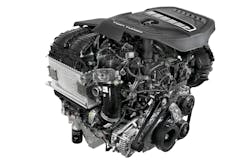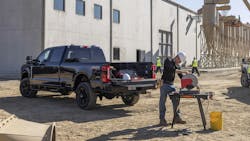2024 Pickup Truck Report
Production of pickup trucks has largely recovered from the Covid effects, and pent-up demand is being satiated. Pickups are still the single most popular class of vehicle sold in the U.S., and they have become more car-like while keeping their hauling abilities.
Pickup truck sales seem to be leveling off but are still strong, staying well above the shrunken numbers of 2020 and ’21. For manufacturers, profit margins on pickups are healthy, yielding returns for stockholders and funds for continued development and production of all vehicle types.
Product variety in pickups has both expanded and contracted as manufacturers introduce new powertrains but cut out older components and slower-selling equipment, including engines and smaller cab configurations. The 4-door crewcab now is the most popular type, covering about 80% of pickup sales industry-wide, builders report. In full-size trucks, extended cabs have become rare, and Ram has dropped its two-door regular cab except in chassis-cab models. Crewcabs are usually the only size offered in midsize and compact pickups. Larger cabs provide extra room for passengers in trucks that see more actual use as sedans, and working folks like the back-seat space for secure storage of tools and supplies.
The growth in size and weight of full-size trucks has alarmed safety experts. The U.S. Army Corps of Engineers shares those concerns because of its involvement with transportation infrastructure. It contracted for specific crash research with the University of Nebraska-Lincoln. The school’s Midwest Roadside Safety Facility did crash testing and found that current guardrails are not sufficient to contain heavy EVs.
Read also: Rear Seat Passengers May be at Risk in Pickups
Manufacturers like Ford say that full-size pickups have become bigger because that’s what customers want.
“The growth in pickup size is driven by customer demands for more space and capacity, alongside styling trends and the need for larger batteries in electric models like the Lightning,” said Kevin Lieberum, Ford Pro commercial truck brand manager. “This evolution reflects ongoing improvements in performance and customer expectations.”
Engine advancements in pickup trucks
Electric pickup trucks
Manufacturers say that fleet customers remain interested in EVs, but the rate of sales growth is less. Buyers seem put off by lack of reliable charging stations. Manufacturers are building networks to support the EVs as they are sold and begin roaming the roads.
Until charging stations proliferate, limited range continues to be an issue. Local use is entirely feasible if reasonably priced vehicles and support equipment can be had. Advancements in battery technologies and identification of domestic supplies of lithium, a key ingredient in li-ion batteries, bode well for the transition to EVs, though it may take longer than some want.
- Ford’s F-150 Lightning is selling well, and demand is climbing, notwithstanding a cutback in production at the factory in Dearborn, Michigan.
- GM and Ram have both prepared electric pickups for production.
- Chevrolet’s electric pickup, the Silverado EV, was introduced with Work Truck trim.
- Rivian continues production of its electric R1T pickup and R1S sport-utility vehicle, and it has just introduced a smaller and lower-priced R2 SUV.
- Tesla has put its CyberTruck into production.
- Lordstown Motors went bankrupt and was fined by the Securities and Exchange Commission. Lordstown re-emerged as NuRide and is pursuing other interests, while rights to the Endurance were sold.
Technological advancements are making pickup trucks more efficient and economical to run. For one thing, internal combustion engines are more durable, with gasoline engines running 200,000 miles or more before serious maintenance is needed, and diesels well beyond that. For better fuel economy, gasoline engines have direct fuel injection to each cylinder, backed by high-pressure fuel systems, along with increasingly advanced combustion design.
In recent years, body panels have become more curved to reduce aerodynamic drag, which lowers fuel consumption. On the other hand, taller and wider noses, needed to house larger cooling systems for more powerful engines, hinder air flow. Higher horsepower and torque are important for customers who actually carry loads and tow trailers as heavy as larger pickups are built for. Builders say owners of heavier pickups, particularly commercial users, take advantage of these capabilities. Surveys show that few owners of light-duty trucks actually do.
Four-wheel drive is now far more common than not, as buyers want their trucks to do more, said Dave Sowers, head of Ram commercial operations. That’s true even for buyers in warm climates.
“Weather, North vs. South, used to govern sales, 4x4 vs. 4x2,” he said. “Not any more. The higher trim levels are almost all 4x4. It costs about $2,000 more, but you get a lot of that back in resale value, and the fuel economy difference is now very small. The systems used to be very heavy, and not so much now.” Aluminum housings for transfer cases, more efficient axles, and independent suspensions help reduce weight.
V-8s fade from light-duty pickups
“That thing got a Hemi?” That line, voiced by comedian Jon Reep in a 2004 Dodge Ram pickups commercial, always elicited a knowing nod and a “Yeah” from the driver of a Hemi-equipped Ram Heavy Duty pickup in the next lane. When the traffic light turned green, the pickup—pulling a trailer with a classic Dodge Charger aboard—outran the Mopar car that Reep was riding in.
The “legendary” 5.7-liter gasoline V-8 soon became widely used in Ram 1500 pickups. For a while, it was also standard equipment in Ram 2500 and 3500 Heavy Duty pickups. Eventually, Ram product planners and engineers introduced a larger 6.4-liter Hemi V-8 to the HD series, complementing the Cummins Turbo Diesel originally offered in 1988. The current 6.7-liter Cummins now goes in 70% of Ram’s HD models.
But the 5.7 gasoline Hemi is being discontinued as Stellantis, Ram’s corporate parent, downsizes engines to meet government-mandated fuel economy and exhaust emissions limits. The Ram 1500 is instead going with a 3-liter inline-six-cylinder engine that will pack twin turbochargers and other advancements. The Hurricane, as it’s called, will come in regular and high-output versions strong enough that most customers probably won’t care much about the Hemi’s demise unless they are really devoted to the idea and sound of a V-8.
“The 3-liter has 420 horsepower and 469 lb.-ft.—more than the V-8 and with more efficiency,” said Sowers. “The HO is 540 horsepower and 521 lb.-ft., which is reserved for high trim levels. The inline 6 has packaging and technical advantages, too,” because it’s narrower, leaving adequate room for accessories like the turbos and aftercoolers. The 3-liter inline-6 will be offered along with the 3.6-liter Pentastar V-6 in Ram’s 1500 pickups; a 3-liter diesel V-6 has been dropped for lack of sales.
Ford pioneered the substituting of turbocharging for displacement. Twelve years ago, it began de-emphasizing its traditional gasoline V-8s, and in 2011 introduced a 3.5-liter EcoBoost V-6 and later 2.7-liter versions. The new, smaller V-6s began appearing in its lighter-duty vans and pickups, including the perennial best-selling F-150, as well as many automobile models.
The EcoBoost 3.5 is also part of Ford’s recent Power Boost hybrid option that adds a 47-horsepower electric motor, a lithium-ion battery, and electronic controls to make them work together. A 5-liter V-8 remains available in the F-150 and is the choice of buyers who prefer the old, reliable way of doing things versus the complexity that turbos suggest. Interestingly, all three engines—the small (by modern standards) V-8, EcoBoost 3.5, and the hybrid engine—claim the same 400-horse output, though the twin-turbo V-6 has the highest torque, at 500 lb.-ft.
For Ford’s larger SuperDuty pickups that carry and tow heavy loads, it’s big V-8s all the way. The 6.8 and 7.4 gasoline V-8s are standard power in the SuperDuties, with the diesel 6.7 optional.
Chevrolet and GMC have stuck with gasoline and diesel V-8s for their Silverado and Sierra 2500 and 3500 series Heavy Duty pickups, and both are 6.6-liter engines for 2024. The gasser is called L8T, and the diesel is still called Duramax. Light-duty 1500 pickups trucks come with 5.3- and 6.2-liter gasoline V-8s, while a 3-liter Duramax V-6 diesel is being dropped. New to the 1500s for 2024 is a 2.7-liter turbocharged inline-4 as standard equipment.
Compacts and mid-size pickups
Ford and General Motors have scored successes with their smaller compact and mid-size pickups, answering demand from customers who don’t want the larger full-size models. That includes some fleets who have realized that for carrying passengers and a few tools and supplies, smaller trucks work as well and often better. GM’s mid-size models, succeeding the earlier compacts, fill that need, even if big Silverado and Sierra pickups outsell them by seven to one, according to one dealer.
Read also: Colorado Offers an Alternative to Full-Size Pickups
Ford’s long-running Ranger compact truck left the U.S. market in 2011 but returned in 2018 as a mid-size model. Ford’s Maverick—a name formerly used for a 1970s small sedan—proved an immediate success when it came out in 2021 as a compact pickup with gasoline-only and gas-electric hybrid powertrains.
Rumors have Ram bringing back the Dakota, but it will only say that it continues to “watch” the smaller-truck market. One consideration is not wanting to cannibalize sales of the Gladiator pickup from Jeep, another Stellantis division.
About the Author

Tom Berg
Tom Berg is widely acknowleged as one of the top truck writers in the industry. He has covered construction for more than 34 years, and has test-driven well over 150 trucks for Construction Equipment.


